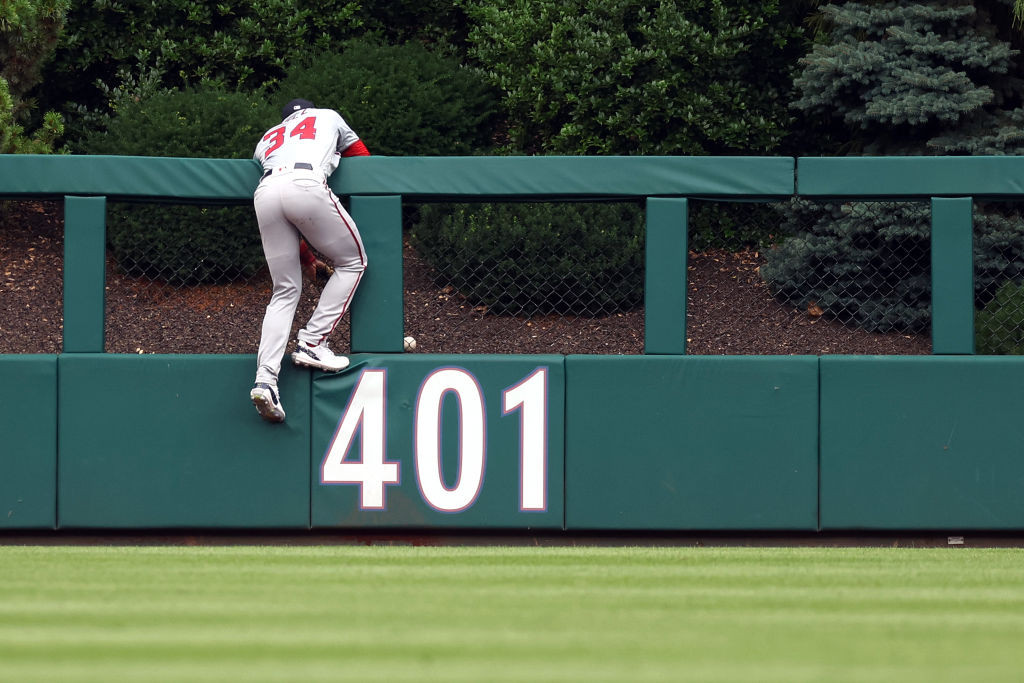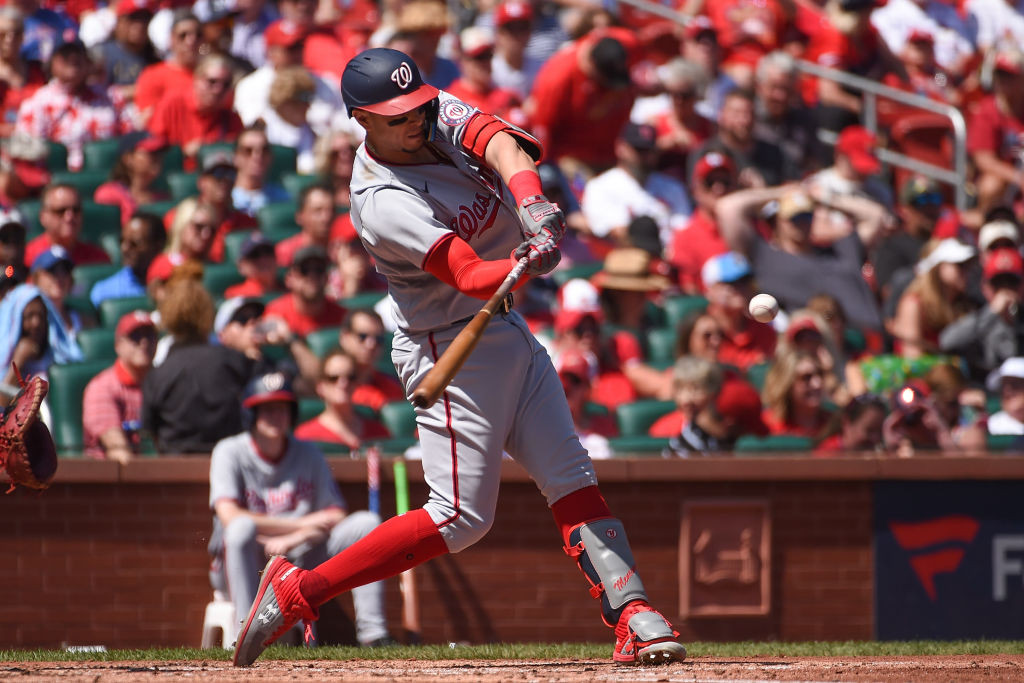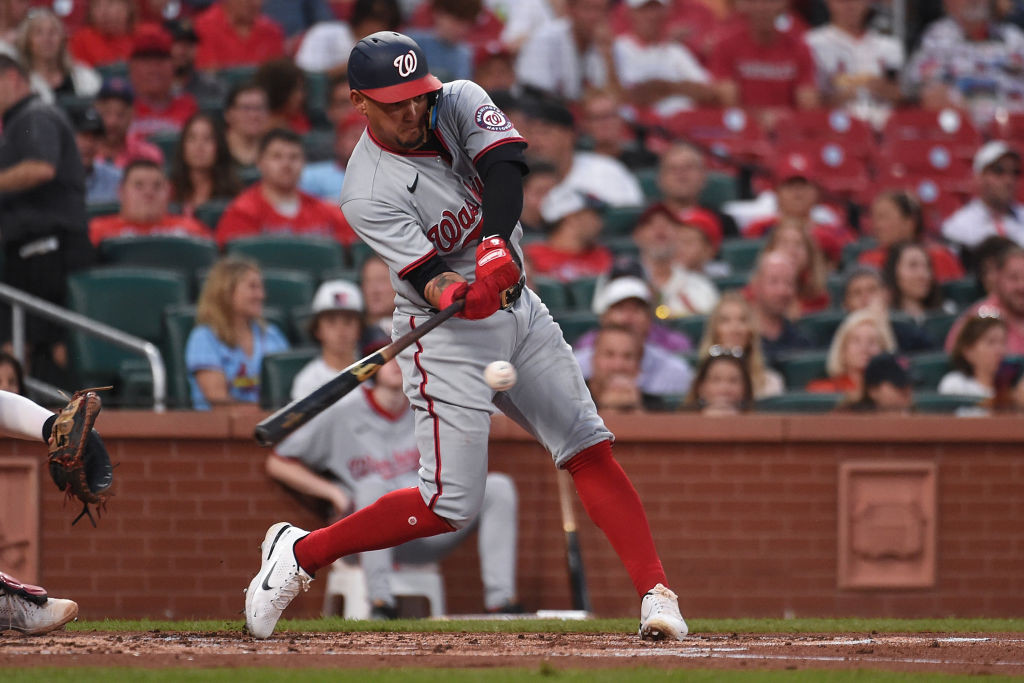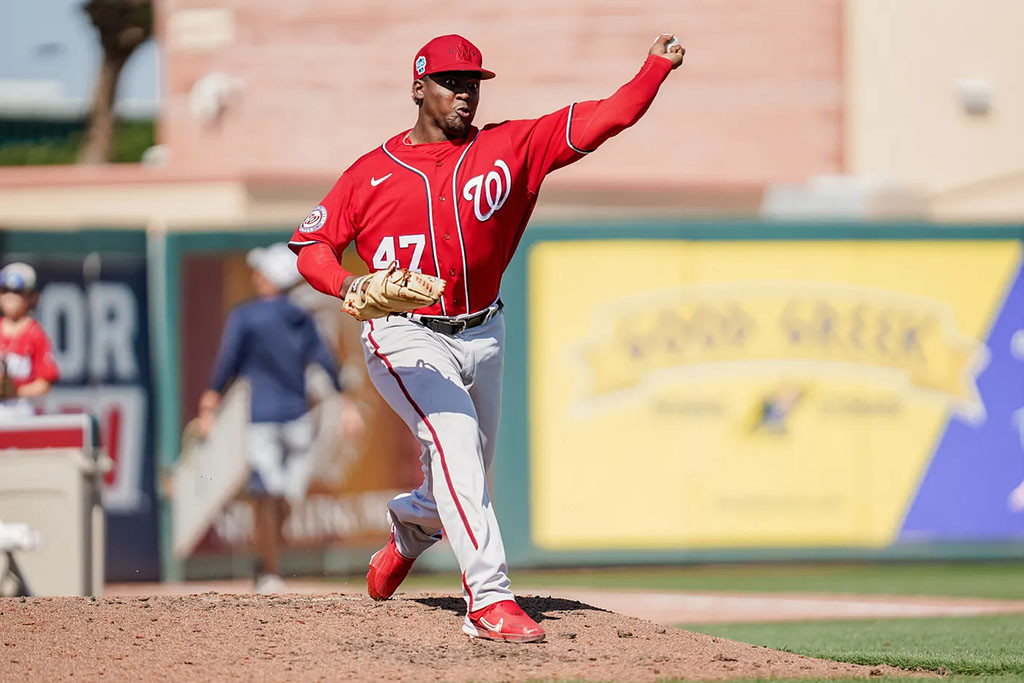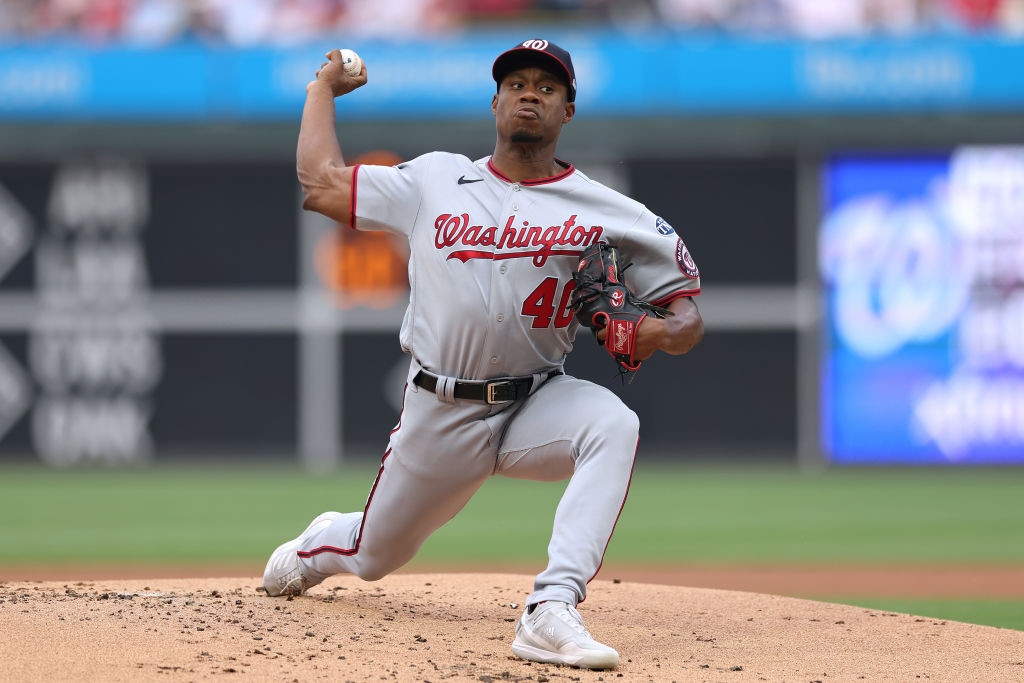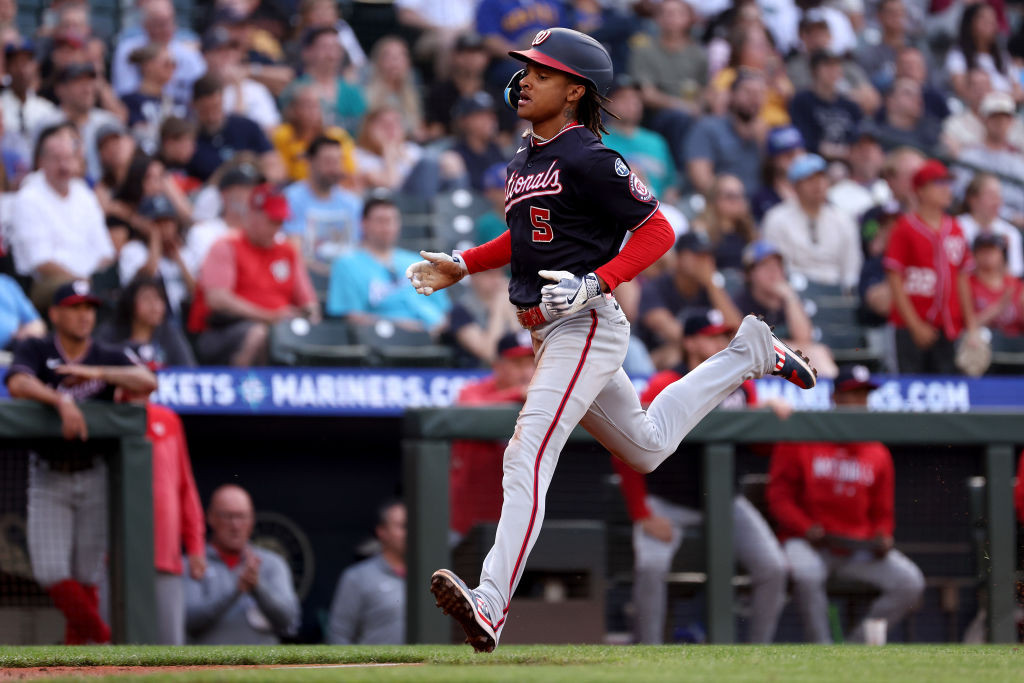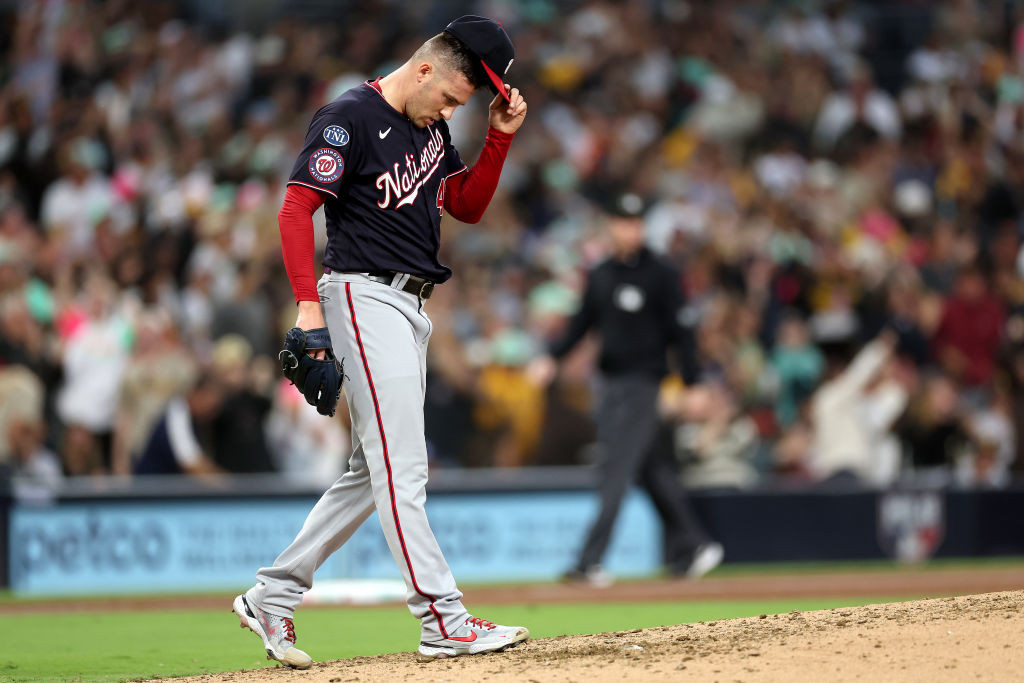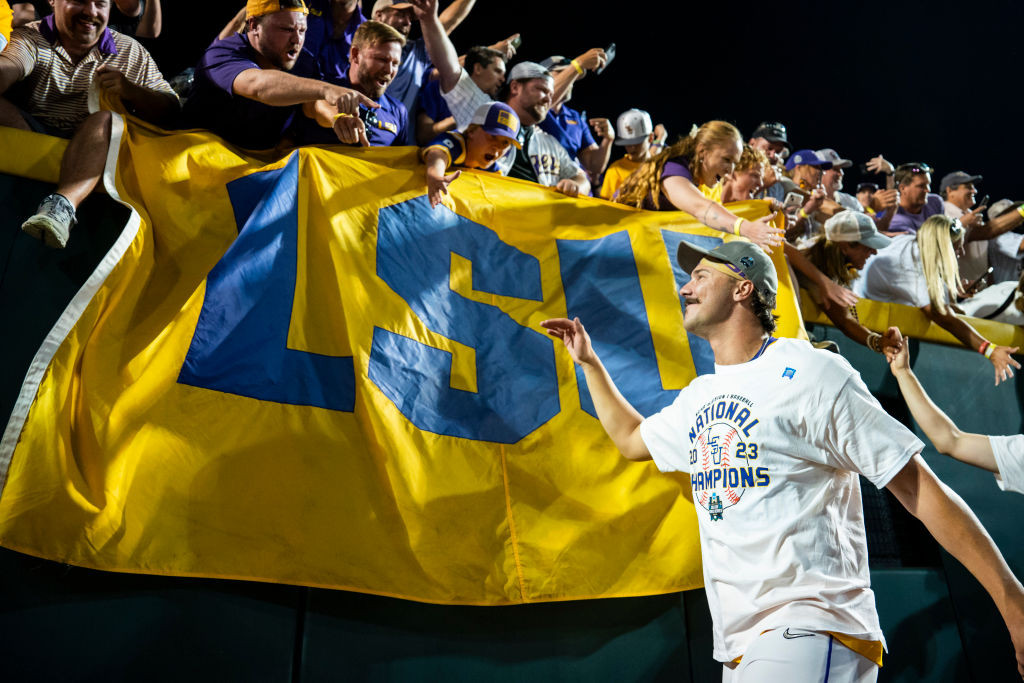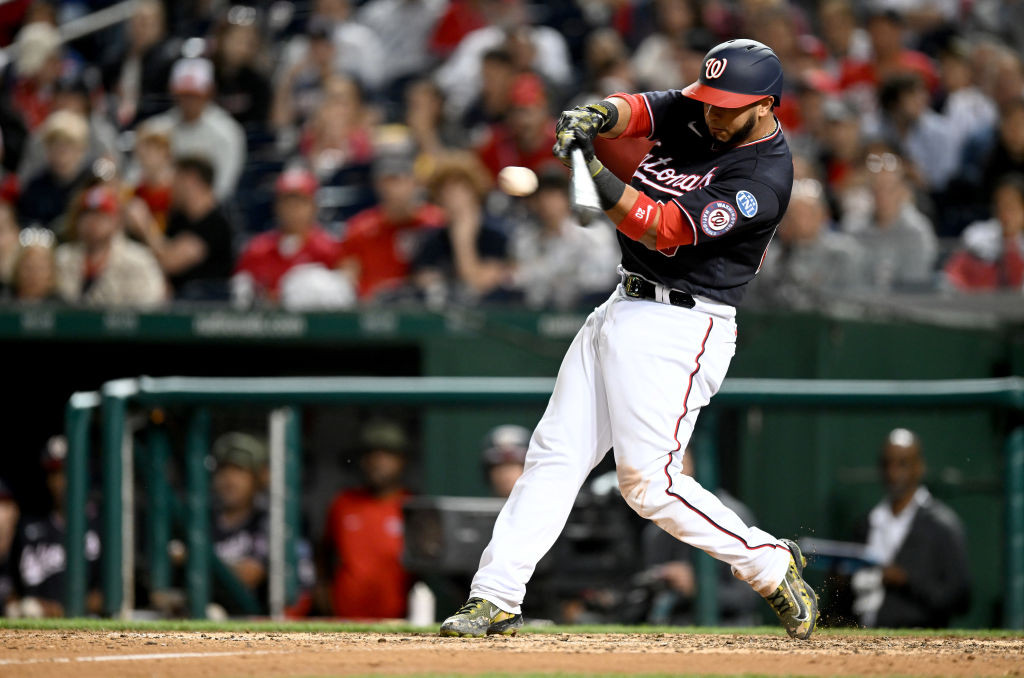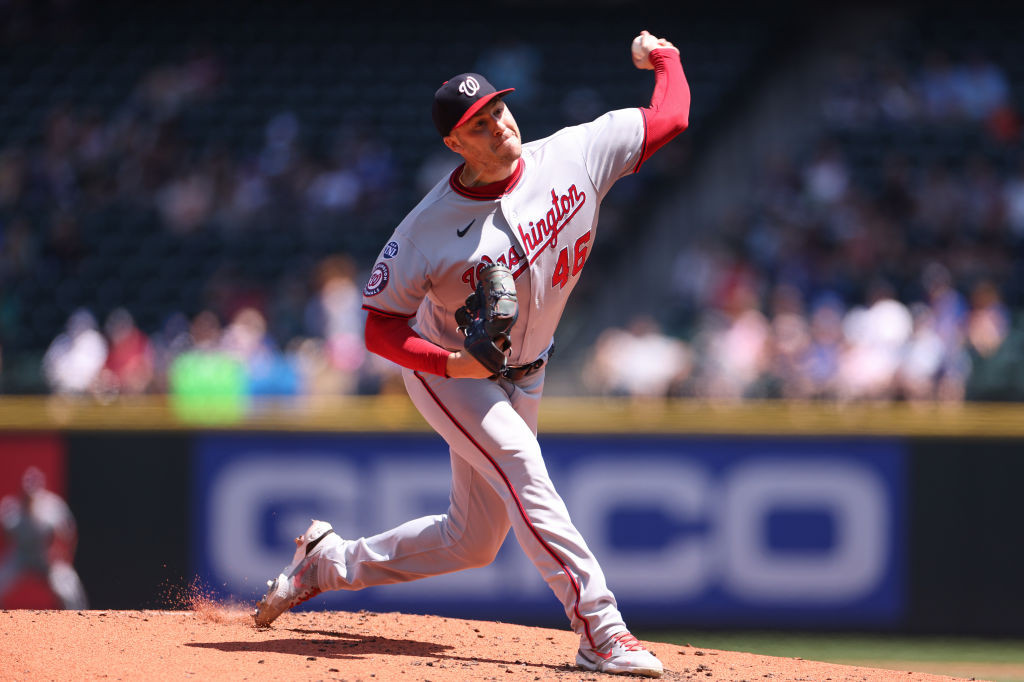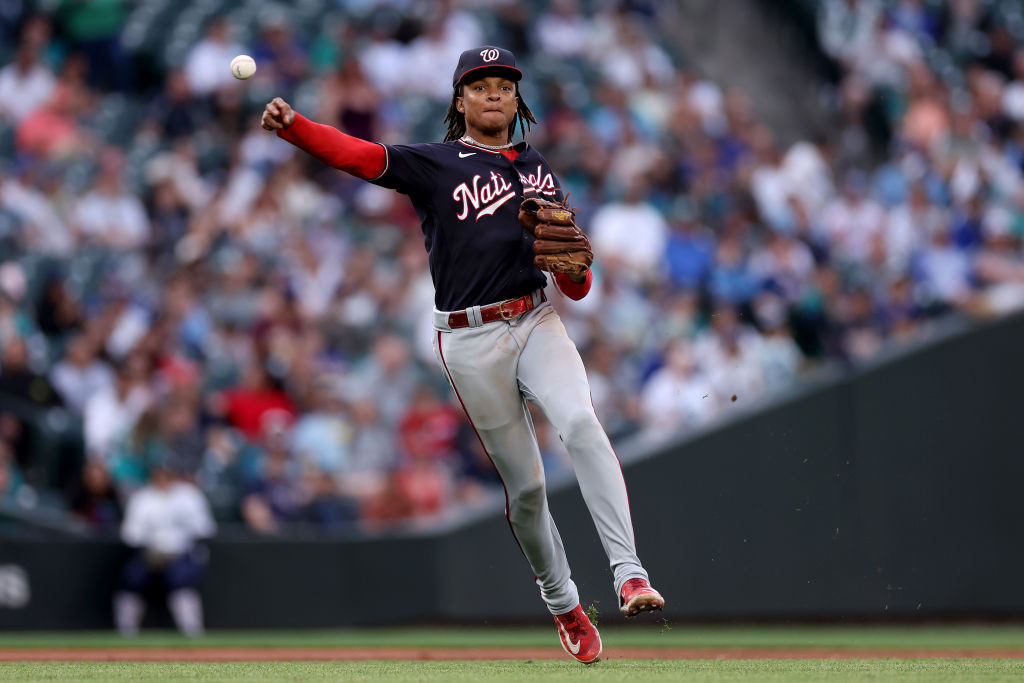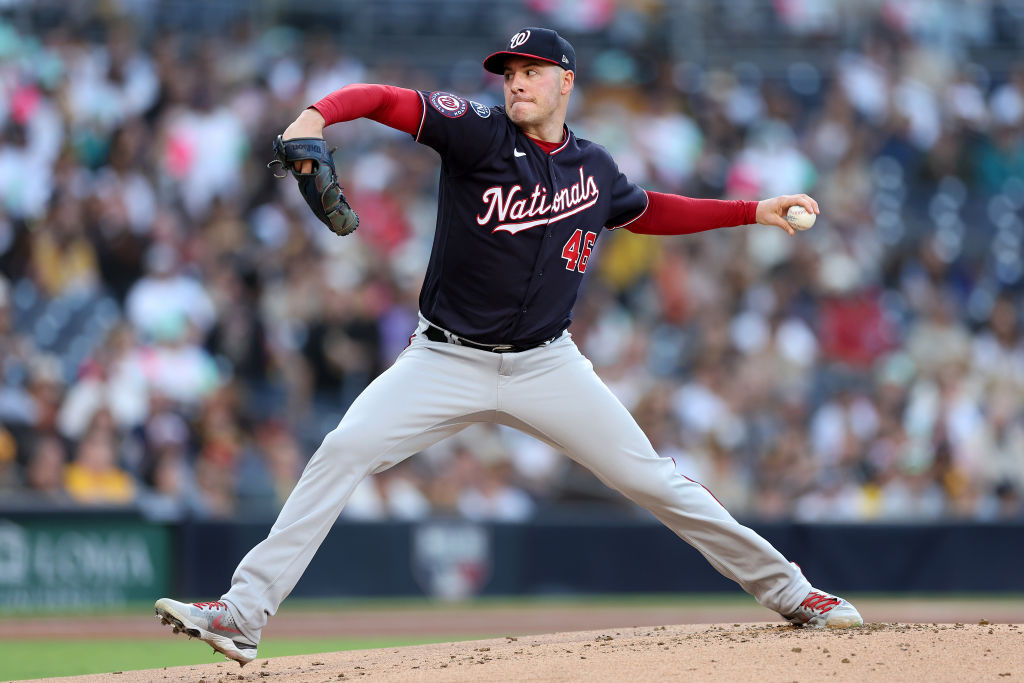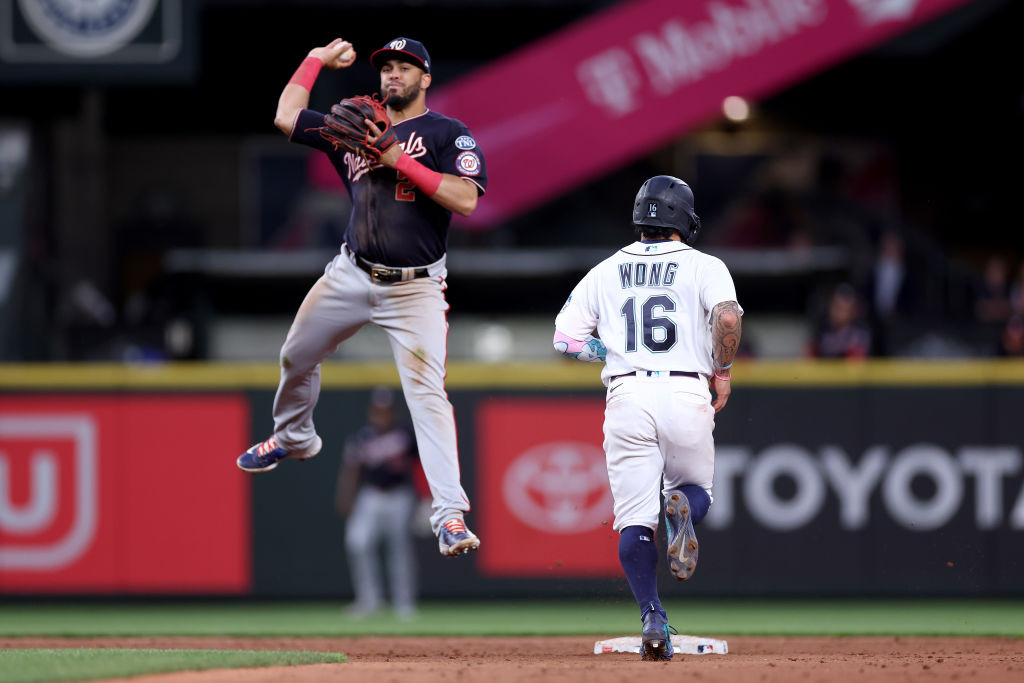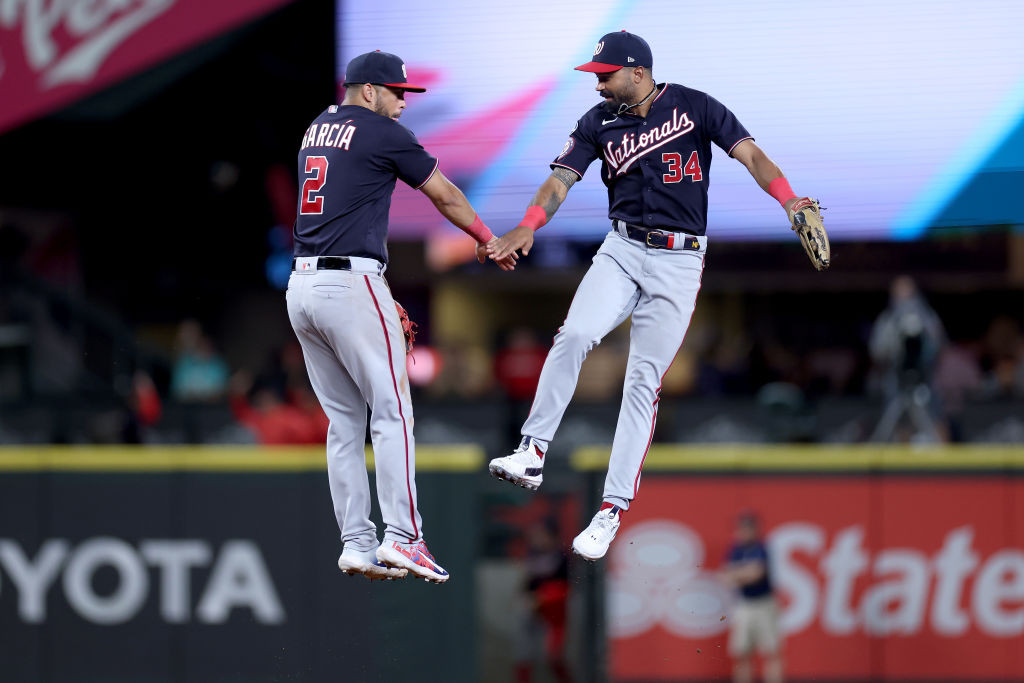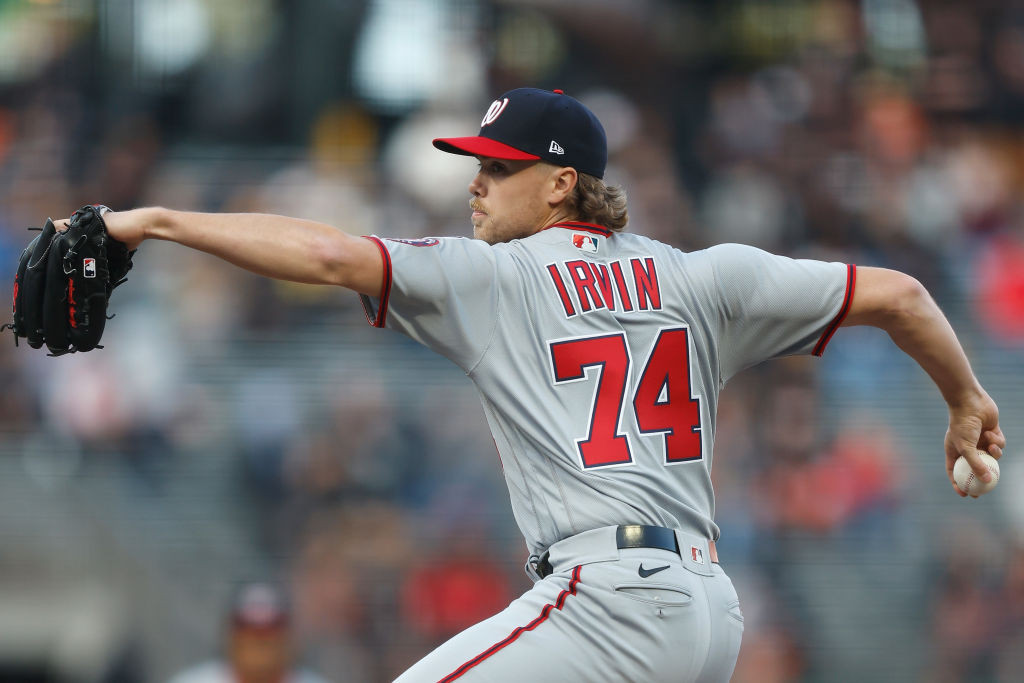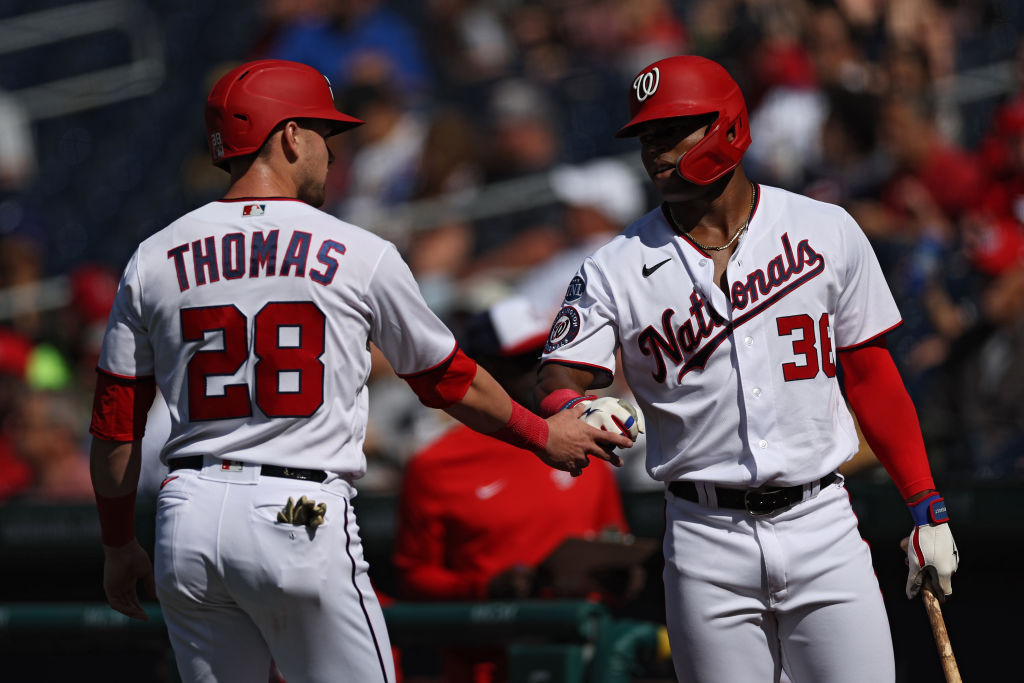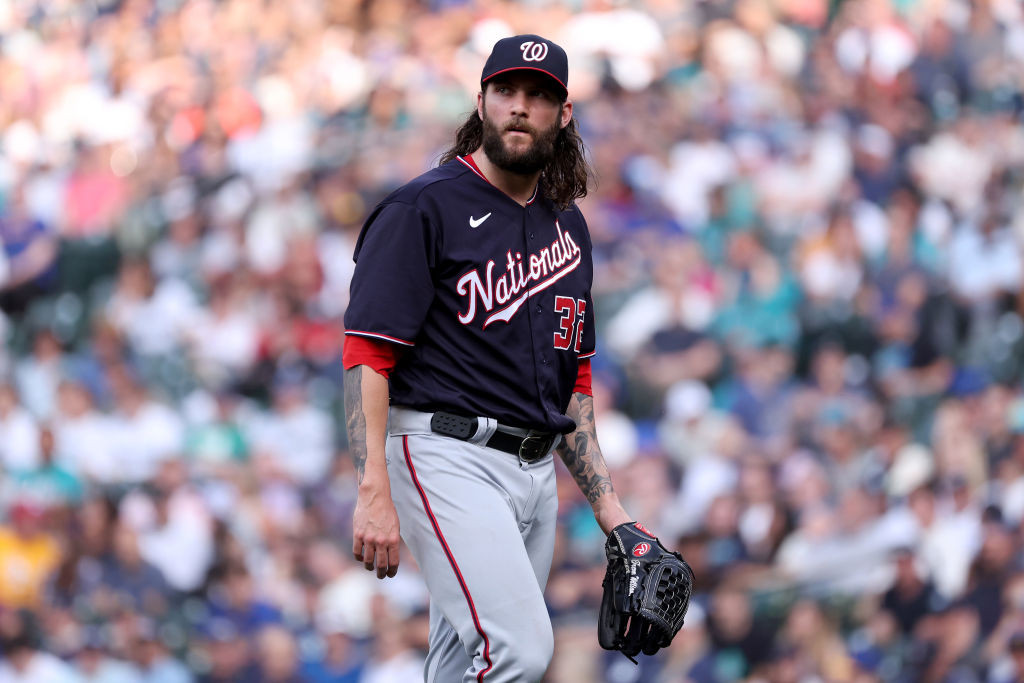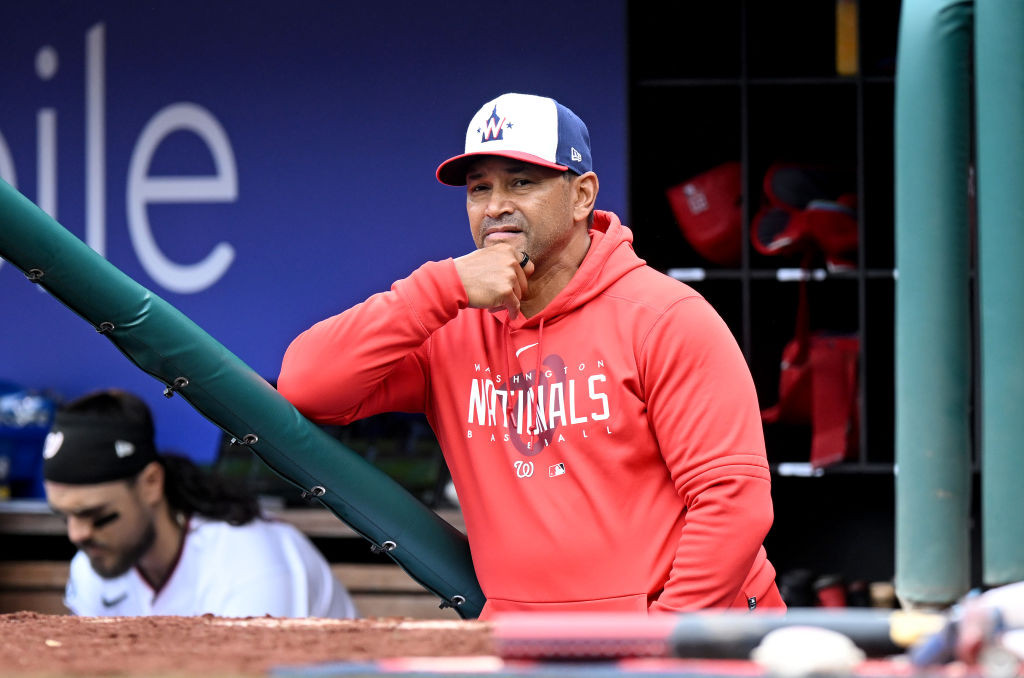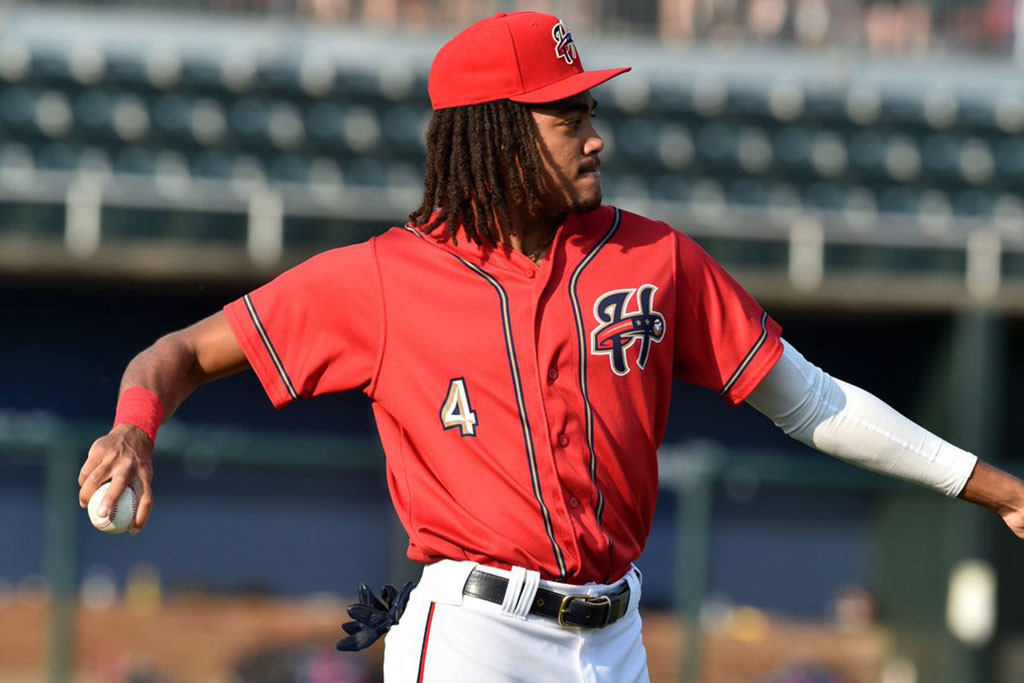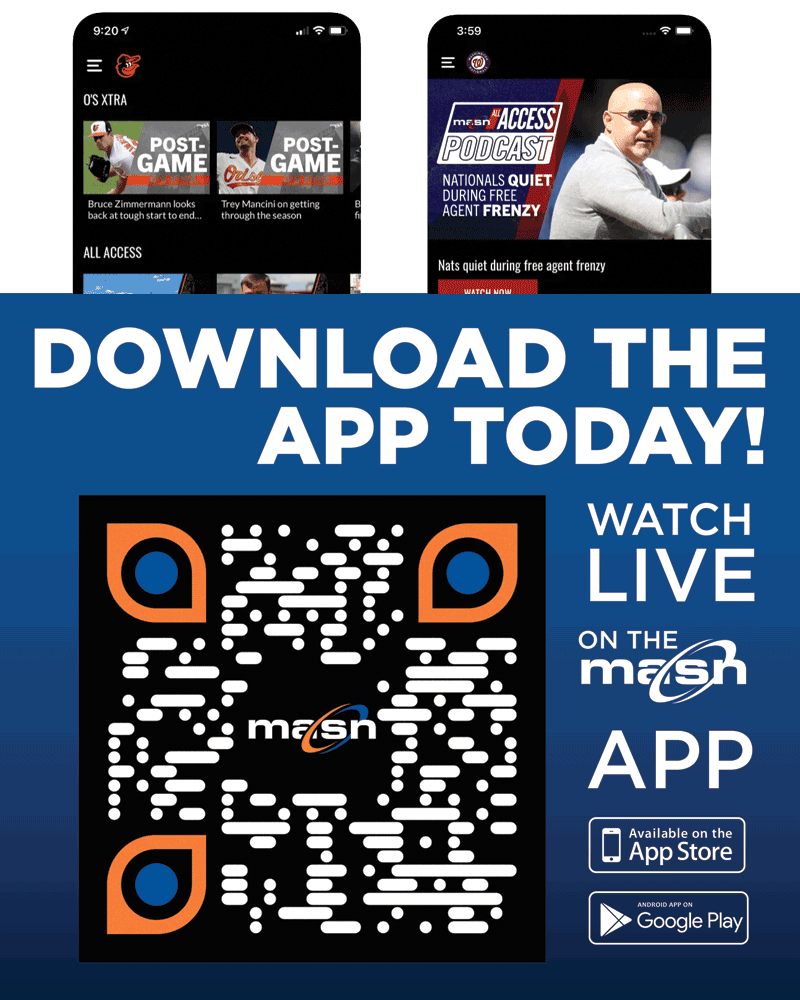PHILADELPHIA – The Nationals were riding high into Saturday’s late afternoon game against the Phillies.
One of their young starting pitchers tossed perhaps his best game as a major leaguer when Josiah Gray shoved for six innings of one-run ball in last night’s 2-1 win.
That set the Nats up today to win their third straight series and to do something they haven’t done since June 27-30, 2021: Have a winning streak longer than three games.
But that all came crashing down with today’s 19-4 thrashing by the Phillies, much to the delight of the 42,784 fans at Citizens Bank Park.
Score aside, the story of this one for the Nationals was MacKenize Gore’s early departure.
PHILADELPHIA – The Nationals are trying to get Joey Meneses right.
Despite a lack of power from the everyday designated hitter, Meneses has been one of the Nats’ more consistent hitters this year.
He enjoyed a career-best 18-game on-base streak from May 21 to June 11, during which he slashed .357/.430/.443 with an .873 OPS, four doubles, one triple, 10 RBI and nine walks to eight strikeouts.
But since that streak ended, he is slashing a paltry .179/.190/.250 with a .440 OPS, four doubles, seven RBIs and one walk to a staggering 18 strikeouts.
So for the fourth time in just over two weeks, Meneses will take a seat as the Nationals face Phillies right-hander Zack Wheeler after he only missed a combined three games over the first 66 of the season (two of those games when he was placed on the paternity list for the birth of his first child).
PHILADELPHIA – Happy July, everyone! The second half of the Nationals' season is officially underway, as they have played 81 games with 81 to go, starting with this afternoon’s second game of a series against the Phillies.
The Nationals have a chance to do something they haven’t done since 2021: Go on a winning streak of more than three games. After winning their third straight last night behind a dominant start from Josiah Gray, the Nationals could also win their third straight series with a victory today.
To do so, they’ll hand the ball to MacKenzie Gore, who is 4-6 with a 3.89 ERA and 1.412 WHIP over his first 16 starts. The 24-year-old left-hander was strong in his last start, striking out nine Padres over five innings of one-run ball against his former team. He pitched a quality start against these Phillies a month ago in D.C., striking out six while allowing three runs over six innings. But ever his own biggest critic, Gore will be looking for more today.
Zack Wheeler will oppose Gore on the mound for the Phillies. The veteran right-hander is 6-4 with a 3.86 ERA and 1.179 WHIP over his 16 starts this year. He got crushed for seven runs and eight hits when he faced the Nats on June 2, the only game Washington won in that three-game series, so he too will be looking to improve today.
WASHINGTON NATIONALS at PHILADELPHIA PHILLIES
Where: Citizens Bank Park
Gametime: 4:05 p.m. EDT
TV: MASN, MLB.tv
Radio: 106.7 The Fan, MLB.com
Weather: Mostly cloudy, 83 degrees, wind 10 mph out to center field
PHILADELPHIA – It was an easy move for the Nationals to make when they found out Patrick Corbin needed to go on the bereavement list for a family matter.
Corbin had just pitched a gem Wednesday in Seattle, leading the Nats to a 4-1 victory over the Mariners. His spot in the rotation won’t come up again until Tuesday against the Reds, so the Nats could add an arm to their bullpen for this weekend series against the Phillies.
Luck would have it Triple-A Rochester was playing a little over an hour away against the Lehigh Valley IronPigs, the Phillies’ Triple-A affiliate. And with Jose A. Ferrer already on the 40-man roster, he could easily be activated to take Corbin’s spot on the active roster during the veteran starter’s time away from the team.
So it was that the Nats recalled Ferrer and had him meet the team in Philadelphia on Friday. After spending much of the season with no lefties in the bullpen, now Davey Martinez has two: Ferrer and Joe La Sorsa.
Ferrer flew up the Nats’ farm system last year. He went 3-2 with 11 saves, a 2.48 ERA, 0.995 WHIP, 78 strikeouts and just 11 walks in 65 ⅓ innings over 48 relief appearances between Single-A Fredericksburg, High-A Wilmington and Double-A Harrisburg last year. Among Nationals minor leaguers, the 23-year-old was third in saves and appearances.
PHILADELPHIA – The Phillies have been one of the hottest teams in June. Unfortunately, the Nationals can look back to when their rivals took two of three in D.C. at the beginning of the month as the turning point.
After the Nats won the first game on June 2, the Phillies won the next two to take the series. Entering this rematch at Citizens Bank Park, the Phils have gone 18-5 with a plus-39 run differential since June 3.
The Nationals needed to figure out a way to slow them down.
Enter Josiah Gray, who has had some past success in this ballpark in the form of a career-high 11-strikeout performance last July. The young right-hander didn’t quite reach that mark, but was just as impressive as he led the Nationals to a 2-1 win over the Phillies in front of 44,261 fans.
“It was a huge one," Gray said after the game. "Any win we get is huge. But yeah, this one definitely feels good. This is the last leg of our road trip and to start it off with a win, it means a lot.”
PHILADELPHIA – Hello from the City of Brotherly love, where America’s pastime will be played by the team representing our nation’s capital and the team representing our nation’s former capital ahead of the Fourth of July holiday.
And welcome to the end of June and the actual midpoint of the major league season. Although some consider the All-Star break (the game's also known as the Midsummer Classic) as the halfway point of the season, after tonight’s game the Nationals will have played 81 of their scheduled 162 games.
The Nationals will turn to Josiah Gray to keep this 4-2 road trip going in a positive direction. The 25-year-old right-hander is 5-6 on the season with a 3.43 ERA and 1.399 WHIP. He pitched 5 ⅓ scoreless innings against the Padres in his previous start, but he was roughed up by this Phillies lineup for four runs over 5 ⅓ when he faced them at the beginning of the month. He has had some success in this ballpark, striking out a career-high 11 batters in a start last July.
Cristopher Sánchez gets the ball for the Phils in tonight’s opener. The 26-year-old southpaw is 0-1 with a 4.05 ERA and 1.050 WHIP over his three major league starts in 2023. Though this is his first time facing the Nats this year, he is 1-0 with a 7.11 ERA and 1.737 WHIP in five appearances (two starts) against them between 2021-22.
Tonight’s first pitch has apparently been delayed by a couple of minutes to accommodate the Phillies’ postgame fireworks. They want to make sure it’s actually dark outside for the show. Maybe the only downside to the pitch clock.
PHILADELPHIA – The Nationals have gone most of this season without a left-handed reliever in their bullpen.
Now they have two.
The Nationals recalled left-hander Jose A. Ferrer from Triple-A Rochester and placed Patrick Corbin on the bereavement list before tonight’s series opener against the Phillies.
“Patrick Corbin is on the bereavement list right now,” manager Davey Martinez said during his pregame meeting with the media. “So we thought we'd bring in Ferrer, one of our young left-handed relievers. Give him an opportunity, hopefully in the next couple of days. With all the lefties they got, get him in the game. So yeah, he'll be here and we'll see how it goes for him.”
Ferrer joins the Nats after his first taste of Triple-A ball, where he was 4-3 with a 3.83 ERA, 1.550 WHIP and 33 strikeouts in 40 innings over 34 appearances. The 23-year-old did not allow a run in his final five outings since June 17 while holding opponents to a .158 average (3-for-19) and striking out nine in six innings over that span.
We are now only nine days from the 2023 Draft, one that not only features some of the best top-tier talent the sport has seen in a long time, but one that also sees the Nationals with one of the top picks for the first time in a long time.
The Nats don’t own the No. 1 pick like they did in 2009 and 2010, but if there’s ever a year to be satisfied with not owning the No. 1 pick, this is it. As many as five players are viewed by experts as No. 1 talents: LSU outfielder Dylan Crews, LSU right-hander Paul Skenes, Florida outfielder Wyatt Langford and high school outfielders Walker Jenkins and Max Clark.
Because they pick second, the Nationals are at the mercy of the Pirates, who have their choice of the entire field. Most experts believe Pittsburgh will take one of the two LSU stars who just won the Men’s College World Series, but there remain valid rumblings they could prefer Langford or one of the high schoolers because of the money they’d save and be able to apply to later-round picks.
The Nats have been widely connected to both Skenes and Crews, with maybe an outside chance they take Langford instead. There’s little buzz about them drafting a high school player with this pick.
So in all likelihood, general manager Mike Rizzo, longtime vice president of scouting Kris Kline and their team of evaluators are going to be selecting someone who played in last weekend’s much ballyhooed national championship series in Omaha. All possess elite skills, all are experienced and all are expected to reach the major leagues in short order.
SEATTLE – Throughout an often frustrating season at the plate, Nationals coaches have needed to remind Keibert Ruiz that his process has been good, even if the results didn’t suggest it. He was hitting the ball well, just not getting hits.
At some point, though, talk is cheap. Doesn’t a hitter need to actually see positive results to justify the process?
“Yes,” Ruiz said with a wide smile when asked that question Wednesday afternoon. “I need to see a lot of results. Everybody wants to get results.”
Then the Nationals catcher got serious again and finished his answer with the standard company line.
“But I’ve got to control what I can control: Having good at-bats, and that’s it,” he said.
SEATTLE – On another day in which the Nationals were on the wrong end of a baserunning call by an umpire, another day in which Davey Martinez was ejected after arguing the aforementioned baserunning call, victory was still assured thanks to the dominant performance from a source that has been anything but dominant for the better part of 3 1/2 years now: Patrick Corbin.
As his manager and other teammates went ballistic over plate umpire Derek Thomas’ controversial sixth-inning call on Keibert Ruiz for running out of the baseline to avoid a tag at the plate, Corbin stayed above the fray and pitched his best game of the season, leading the Nats to a 4-1 win and a series victory over the Mariners.
"Look, you can say whatever you want about Patrick," Martinez said of his beleaguered veteran lefty. "What I know about Patrick is he's going to take the ball every five days. For me, that's awesome. And I love him for that."
Corbin tossed seven scoreless innings, scattering five singles without issuing a walk. He struck out nine, and needed only 102 pitches to complete those seven zero-filled frames to emerge with his fifth win of the year while lowering his ERA under 5.00 in the process.
"That's the end goal: Get as many wins as we can, and have everybody do their job," Corbin said. "Sometimes, it does get frustrating, but you've got to continue to grind and try to focus on the positives and learn from mistakes. I'm not going to get too high after this one, just look at some of the things I did well and try to improve and get ready for my next one."
SEATTLE – The Nationals wrap up the West Coast portion of their nine-game road trip this afternoon with a matinee against the Mariners. They’ll do so without two regular members of their lineup starting, each for different reasons.
CJ Abrams is sitting after getting hit by a pitch on his right elbow in the top of the seventh Tuesday night. It was actually the second time the young shortstop was hit in that location during this trip, and this time it swelled up enough to warrant departing the game.
Abrams did initially remain in Tuesday’s game and proceeded to steal second after reaching. On the slide, he appeared to get spiked on his right hand. When the inning ended, he remained in the dugout, with Ildemaro Vargas taking over at shortstop for the final five frames of an 11-inning victory.
Abrams was walking around the clubhouse this morning with his right arm in a sleeve after receiving treatment. He didn’t sound concerned about missing any length of time.
“He’s a little sore; he’s getting worked on this morning,” manager Davey Martinez said. “He should be available to pinch-hit, play some defense later on in the game. Just giving him a little breather. He’s a guy who got hit twice in the same spot in a week. He woke up today a little sore.”
SEATTLE – The Nationals have spent an inordinate amount of time on the West Coast this season. Today, they play their 25th road game against West division opponents. Compare that with only six road games against Central teams and only nine road games against East teams. They’ve made four separate trips to California in three months.
The good news: Today is the last time the Nats will play west of St. Louis this season. And they would love to head back east with another win, not to mention a 4-2 record in San Diego and Seattle before departing for Philadelphia.
Davey Martinez’s lineup for the finale against the Mariners does not include CJ Abrams, who was hit by a pitch on the right elbow Tuesday night and had to depart. It does not include Joey Meneses, who gets a rare day off. It does include both Keibert Ruiz (who is DHing) and Riley Adams (who is catching).
Patrick Corbin gets the start, hoping for better results than his blowup start in San Diego to begin this trip (seven runs in five innings). The Nats could certainly use some length from the left-hander today after playing 11 innings Tuesday night.
WASHINGTON NATIONALS at SEATTLE MARINERS
Where: T-Mobile Park
Gametime: 4:10 p.m. EDT
TV: MASN2, MLB.tv
Radio: 106.7 FM, MLB.com
Weather: Sunny, 70 degrees, wind 6 mph out to center field
SEATTLE – Luis García’s RBI single in the top of the 11th was a key moment in the Nationals’ wild, 7-4 victory over the Mariners on Tuesday night. His play at second base throughout the game might have been just as significant, and certainly eye-opening to the team at large.
In what was arguably his best defensive game of the season, García turned two key late double plays. And he nearly turned a third one with an incredibly high degree of difficulty.
With runners on the corners and nobody out in the bottom of the seventh of what was a tie game at the time, Seattle’s Kolten Wong hit a chopper to short. Ildemaro Vargas fielded it and threw the ball to García at second base for the first half of what looked like a routine 6-4-3 double play that would concede the go-ahead run.
But instead of throwing to first, García turned against his body and fired to the plate, where Keibert Ruiz caught the throw and tagged a sliding Jarred Kelenic. Plate umpire Brennan Miller called Kelenic out, and the Nats thought they had just pulled off a rare 6-4-2 double play.
The Mariners, though, challenged the call. And upon replay review, it was determined Kelenic barely slid into the plate before Ruiz could apply the tag.
SEATTLE – The weirdest game of the Nationals’ 2023 season included four pitch clock violations, plus one that was overturned after the umpires huddled up. It included players and coaches from both benches coming onto the field to break up an argument over an accusation Jeimer Candelario was signaling pitch locations while leading off second base.
It included CJ Abrams departing with an injury after getting hit by a pitch on the right elbow. It included several jaw-dropping plays by Luis García, including one that nearly saved the day in the seventh … until umpires overturned their original call upon review and awarded the Mariners the go-ahead run.
It included Keibert Ruiz blasting a game-tying homer in the eighth, the young catcher finally rewarded for the loud contact he’s been making for several weeks. It included a no-doubles defense by the Nats that actually played a ball into a double.
And it ultimately included two desperately needed clutch hits from Lane Thomas and García to propel the Nationals to an exhausting 7-4 11-inning victory.
"They fought," manager Davey Martinez said. "This team is relentless. They don't give up. They stay focused. They stay in the game. And we come out victorious in the end, which was awesome."
SEATTLE – Davey Martinez’s tirade against Doug Eddings last week after the longtime umpire ejected the Nationals manager for arguing balls and strikes generated plenty of video clicks and chuckles from all who watched the replay. Martinez understood that would happen when he got down on his hands and feet and mockingly “caught” a pitch two inches off the ground to show Eddings just how low his strike zone was.
Martinez’s real concern in that moment, and in the days since, though, was how CJ Abrams would respond to it. It was a low strike three call to Abrams that initiated the firestorm in the first place, and Martinez worried his young shortstop would change his approach because of it.
After weeks of work to lay off pitches below his knees, Abrams was starting to show a better eye at the plate. Would that no longer be the case if he was taking those pitches and still striking out due to overeager umpires?
“He’s young, and whenever he gets a call that’s controversial, you see that he tends to expand a little bit more,” Martinez said. “We have to always tell him: ‘Do not let the umpires dictate what you’re trying to do up there. Understand who you are, and understand the pitch you’re looking for. And stay in the zone.’”
The evidence since last week’s incident has actually been encouraging. Abrams has continued to produce good at-bats during this West Coast trip, and he enters tonight’s game against the Mariners batting .393 (11-for-28) with three doubles and a homer over his last eight games.
SEATTLE – Monday night’s series opener was a disappointing one for the Nationals, who squandered an early 3-1 lead against Mariners ace Luis Castillo and wound up losing 8-4, with Jeimer Candelario standing at the plate watching a pitch well out of the zone called strike three with the bases loaded and two outs in the ninth. They can only hope for better results tonight.
The pitching staff should be in better shape tonight, with everyone outside of Cory Abbott available out of the bullpen. That could take some pressure off starter Jake Irvin, though the rookie right-hander will be motivated to follow up his back-to-back strong outings with another one. He allowed just one run a piece to the Marlins and Diamondbacks, completing six innings against Arizona.
Seattle has a rookie right-hander of its own on the mound tonight in Bryan Woo. The 23-year-old, a sixth-round pick in the 2021 Draft, makes his fifth career start. His debut was ragged (six runs in two innings against the Rangers) but he’s been good since (2.30 ERA, 21-to-4 strikeout-to-walk ratio against the Angels, White Sox and Yankees).
WASHINGTON NATIONALS at SEATTLE MARINERS
Where: T-Mobile Park
Gametime: 9:40 p.m. EDT
TV: MASN2, MLB.tv
Radio: 106.7 FM, MLB.com
Weather: Partly cloudy, 73 degrees, wind 5 mph out to center field
NATIONALS
RF Lane Thomas
2B Luis García
3B Jeimer Candelario
DH Joey Meneses
LF Corey Dickerson
C Keibert Ruiz
1B Dominic Smith
SS CJ Abrams
CF Derek Hill
SEATTLE – Lane Thomas made plans a while back to spend his All-Star break at the beach with his wife. He might need to find out if those reservations are refundable, because with each passing day it looks more and more like he’s going to be spending his All-Star break right here in Seattle with the rest of baseball’s best players.
Thomas continues to make a compelling case for himself to represent the Nationals in the All-Star Game, set to be played two weeks from today at T-Mobile Park. What initially looked like a red-hot month at the plate has since turned into a prolonged stretch of success as good as anyone in the sport has produced this season.
With another homer and another RBI double during Monday night’s 8-4 loss to the Mariners, Thomas raised the bar even further. He now has 14 home runs, all of them coming since May 1. He’s now batting .297 with an .860 OPS, and though those numbers may not rank among the league leaders, they’re depressed a bit only because of his slow start to the season.
When Thomas hit his first homer May 1 against the Cubs, he was batting .260 and slugging a paltry .302. He has been nothing short of MVP-like ever since.
In 51 games played since that notable date, Thomas is batting .314 and slugging .614. Extrapolate all of his stats during that stretch over a 162-game season, and his totals would be mind-blowing: 127 runs, 206 hits, 51 doubles, 44 homers, 98 RBIs, 16 steals and a .967 OPS.
SEATTLE – Had they played clean baseball tonight, the Nationals might still have lost to the Mariners. Their lineup might still have gone silent after scoring three early runs off Luis Castillo. Trevor Williams might still have been pulled after four labored innings. Cory Abbott might still have surrendered the go-ahead runs in relief. Jeimer Candelario might still have struck out looking – at a pitch well outside the strike zone, for what that's worth – with the bases loaded and a last-ditch chance to tie the game with one swing in the top of the ninth.
But they certainly weren’t going to win this game playing the unclean brand of baseball they put on display in the opener of a three-game series at T-Mobile Park.
There was a comical error by Dominic Smith, who flipped the ball to first base without realizing nobody was there to catch it. There was a perfect throw by Keibert Ruiz to nab Jarred Kelenic trying to steal second, if not for CJ Abrams not holding the tag long enough. There was an automatic balk called on Williams for disengaging from the pitching rubber three times during the same at-bat.
All of that, along with some ineffective pitching and a lack of offense once the third inning ended, conspired to deal the Nationals an 8-4 loss to Seattle and halt whatever positive momentum they generated during back-to-back wins in San Diego over the weekend.
"Those little things become big things, as we saw," manager Davey Martinez said. "We'll talk about these things again tomorrow. Hopefully, tomorrow we play a cleaner game. Because this game was close for a while there. It was a good game. The boys battled back, but I'd like to see us get through that one inning that kind of beat us."
SEATTLE – A Nationals bullpen that has gone through a number of changes in the last week experienced another one today when the club promoted right-hander Amos Willingham from Triple-A and optioned Paolo Espino back to Rochester.
This move comes only two days after the Nats called Espino up to replace Chad Kuhl, who was designated for assignment. (The club officially requested unconditional release waivers on Kuhl today, making him a free agent.)
Willingham, 24, made a name for himself in the organization early this season, stringing together 10 consecutive scoreless appearances with 14 strikeouts and only one walk for Double-A Harrisburg. That earned him a promotion last month to Triple-A, where he wasn’t as dominant (3.46 ERA, 11 strikeouts, eight walks over 13 innings), but still pitched well enough to earn consideration for another promotion.
“I knew this could be a big year for me,” he said. “I needed to go in and take care of everything I needed to do, and I knew there would be opportunities to move up. I had no idea it would happen this fast. I was thinking at this point in the year maybe get to Triple-A, and then maybe be in Triple-A until September and maybe get a look up here. But it’s all happened so fast, it’s hard to really fathom the entire process.”
The Nationals might have called Willingham up Saturday to take Kuhl’s spot, but he had just thrown 30 pitches over two innings and likely wouldn’t have been available for another couple days. So they instead recalled Espino, who wound up pitching the ninth inning of Sunday’s 8-3 win in San Diego but retired only two of the five batters he faced, prompting manager Davey Martinez to summon closer Hunter Harvey for the final out.
The Nationals will have two of their top prospects representing the organization at next month’s All-Star Futures Game.
Outfielder James Wood and third baseman Brady House have been selected to represent the Nats in the 2023 SiriusXM All-Star Futures Game, the announcement coming tonight on MLB Network.
Wood, 20, is the No. 5 prospect in baseball according to Baseball America and the No. 6 prospect per MLBPipeline.com’s recently updated rankings. As the Nats’ top overall prospect per both publications, he leads the Nats’ minor league system in home runs (12), RBIs (52), slugging percentage (.536), OPS (tied for first, .903), triples (six), extra-base hits (33) and total bases (128).
From April 25 to May 28, Wood posted a 30-game on-base streak, the longest active streak in all of Minor League Baseball at the time. He hit .299 with a .415 on-base percentage and a .626 slugging percentage during that stretch.
In 66 games between High-A Wilmington and Double-A Harrisburg, Wood has hit .272 with 15 doubles, six triples, 12 homers, 52 RBIs, 37 walks, 13 stolen bases and 46 runs scored. He was promoted to Harrisburg on May 28, an early promotion compared to some of the Nats’ top prospects of the past. In the week leading up his promotion to Double-A, Wood went 9-for-19 (.474) with a double, triple, three home runs, seven RBIs, four walks, two stolen bases and eight runs scored in his last five games with the Blue Rocks.

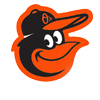
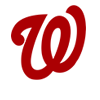

-1745819772711.png)
